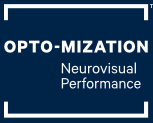Vision Skills

Poor visual skills can lead to difficulties with reading, learning, overall school performance and even sports. This happens when a good visual foundation is not developed properly and stress causes the unstable system to break down under too much load.
Visual skills can also be influenced by many physiological, environmental and psychological factors such as development, disease, infection, nutrition, fatigue, environmental stress, emotional stress, opportunity, attention and attitude. Some individuals are better than others at compensating for these influencing factors.
Fortunately, vision therapy can help patients to use their visual system more efficiently and automatically by building neural pathways at any age, so they will be better equipped to handle heavier loads on their visual system. This can be achieved through vision therapy. At our Opto-mization™ Neurovisual Performance Centres, we are pleased to offer testing and treatment for a variety of these conditions.
Understanding Visual Input, Put-Put, and Output
To better understand how to fix visual problems, we need to understand the visual system. For sake of discussion, the visual process can be broken down into the following categories:
- Visual Input
- Visual Processing
- Visual Integration Skills
We can break down visual skills for the sake of definition, however, it is important to realize that these skills coordinate together almost simultaneously. The neural pathways of vision are highly interconnected, which is why 2/3rds of the brain pathways are involved with vision, while the other 1/3 is all the other senses combined.
Visual Input Skills
If you don’t get correct information input, how can you get good output?
A good analogy is of a television that works really well, but the antenna is broken. The broadcast of the information has a lot of noise and causes poor reception. If the visual system has a lot of noise coming in due to inefficient input skills, it will affect how we perceive and process the information to derive meaning from it.

Visual Acuity
Visual acuity is a measure of the sharpness of eyesight, or how clearly you see. It is influenced by eye structure, stress and the focusing system. It is the ability to identify a shape of a certain size at a certain distance, however, it gives no information on whether or not meaning is obtained from what is seen. The Snellen fraction (20/20, etc.) is most often used in an exam to measure visual acuity. Though most of the time, doctors try to get their patients to see 20/20 or better, there are particular circumstances where greater visual function is best achieved with a less clear image.
One common factor that can negatively influence visual acuity is refractive error.
Refractive error is caused by how the light is bent into the eye. Myopia (nearsightedness), Hyperopia (farsightedness), and Astigmatism occur when the shape of the eye is not ideal enough for the light rays to fall on the fovea (the only place the image can be seen sharply). To learn more, visit the refractive error section.
Other causes of decreased visual acuity are ocular disease or amblyopia (lazy eye). Even if there is no significant pathology or power difficulties, a person can have difficulty seeing clearly because of an inefficient accommodative (focusing) system.
Keeping an image clear at all distances is a factor in visual input.
Assuming the eye is healthy, it is the accommodative system that actively keeps an image clear at various distances (switching easily and effortlessly between distance and near), as well as sustaining clarity at the target, especially up close, for long periods of time.
Accommodation
Vergence
Accommodation and vergence working together
These two systems (along with your pupil that changes size to allow the proper light to come in and helps with depth of focus) ideally work together to keep images you are attending to clear and single.
You can think of accommodation as finding the distance at which to focus (defining the plane focus), while vergence defines the point of focus within the plane. The closer we want to focus and point our eyes, the more “power” or effort we need to do so.
It is important to have effortless control over these systems so when the going gets tough and you need to work a little harder, you can! It is also important this process is automatic.
Accommodation and vergence should work hand in hand with liberal degrees of freedom between the two to help bring you clear and single images. If an individual exhibits extra effort to maintain single and clear vision, symptoms usually worsen over time. Unfortunately, some people (especially kids!) can develop adaptation strategies to cope with these problems, like avoidance or amblyopia, so they may end up not having a variety of vision symptoms.
If these two systems are not working smoothly or efficiently together and one system is working too hard or not hard enough, the result is a visual system that fatigues and basically breaks down after short periods of visual stress. Usually this results in the brain fighting between either keeping the image clear, but double or keeping the image fuzzy and clear.
Eye Coordination – Binocularity
Depth Perception
Eye Movement Skills – Ocular Motility
Signs & Symptoms of Visual Input Skill Problems
Efficient academic and athletic performance depends on the ability to focus the eyes rapidly and automatically, regardless of the working distance to make targets clear. Activities such as reading and writing require the ability to sustain and maintain prolonged focus up close. Copying from one place to another requires a change in accommodative focus that is rapid and efficient. Visual focus is also intimately related to the ability to sustain visual attention.
Signs / Symptoms of Poor Eye Teaming
- Double vision
- Words moving around on a page
- Motion Sickness
- Difficulty catching/hitting a ball
- Decreased depth perception
- Inefficient eye-hand or eye-body coordination
- Short attention span for near work
- Headaches
- Closing or covering of one eye
- Excessive blinking
- Holding a book too close
- Poor handwriting
- Reduced reading comprehension
Signs / Symptoms of Focusing Difficulties
- Excessive time completing assignments
- Excessive time copying from the board
- Daydreaming
- Avoiding close work
- Blurring of print
- Fatigue
- Headaches
- Eyes “hurt” or “tired”
- Reduction of comprehension when reading
- Reading slowly
- Short attention span
- Vocalizes when reading “silently”
Signs / Symptoms of Poor Eye Movement Control
- Use of a finger or marker when reading
- Loss of place when reading, writing or copying
- Difficulty copying from the board
- Skipping or repeating words
- Head movement side to side while reading
- Difficulty in sports
Note that many medications can negatively effect the visual system. Common medications that can affect accommodation include antihistamines, Phenytoin, Ritalin and other amphetamines used for ADD, and Dexedrine.
